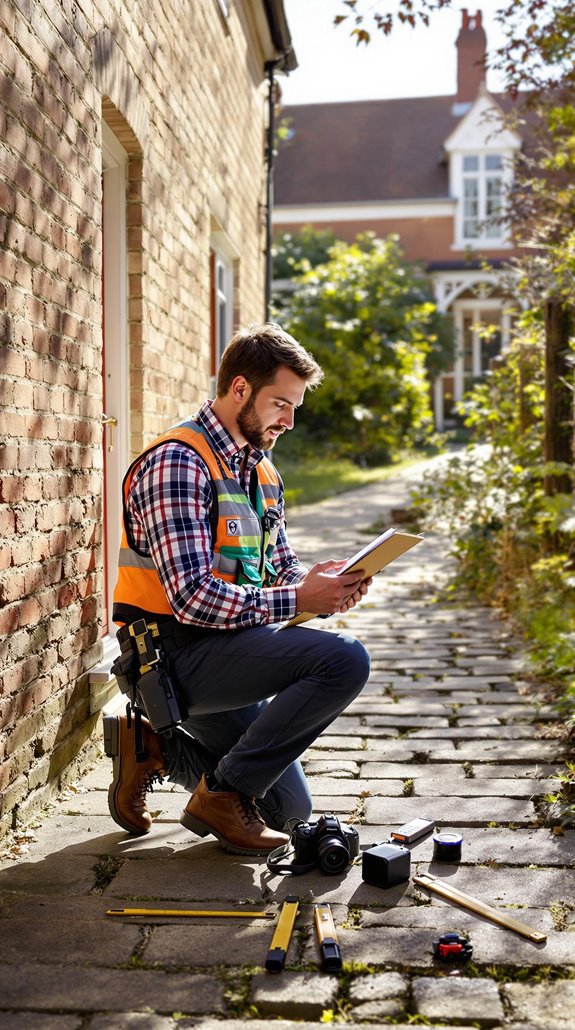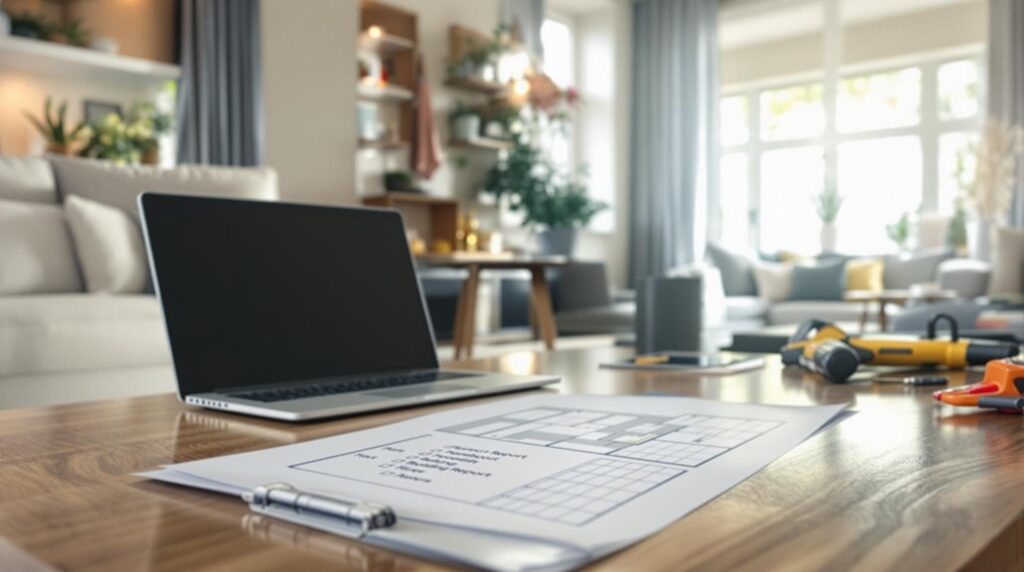I’ll help you navigate one of the most essential decisions you’ll face as a UK property buyer: choosing between a Homebuyers Report and a Building Survey. This choice directly impacts your wallet, your peace of mind, and potentially your future repair bills. The wrong survey type can leave you exposed to costly surprises, while the right one protects your investment. Let me show you exactly how to match your property’s needs with the survey that’ll serve you best.
Key Takeaways
- Level 2 HomeBuyer Reports suit properties under 80 years with no visible defects, costing £400-£900.
- Level 3 Building Surveys are essential for pre-1920s properties, listed buildings, or unconventional construction, costing £600-£1,500+.
- Building Surveys investigate concealed spaces and typically uncover hidden repairs worth £5,000-£15,000 in older properties.
- Start with HomeBuyer Report for initial offers, then switch to Building Survey if concerns arise during purchase.
- Properties with visible defects like cracks or sagging roofs always require Building Surveys regardless of age.
Understanding the New RICS Home Survey Terminology

Since the RICS Home Survey Standard launched in September 2021, property surveys have undergone their biggest transformation in decades. I’ll walk you through what’s changed and why it matters for your property purchase.
The old survey names you might’ve heard—Condition Report, HomeBuyer Report, and Building Survey—have been replaced with a cleaner three-tier system: Level 1, Level 2, and Level 3. This isn’t just cosmetic rebranding; it’s designed to eliminate the confusion that’s plagued homebuyers for years. The new framework serves as a single standard for condition-based home surveys, ensuring all RICS professionals follow the same best practice benchmark. Conducting a new build survey is key to identifying hidden defects that could lead to costly repairs.
You’ll now find consistent traffic light ratings across all survey levels—red for urgent repairs, amber for near-future issues, and green for sound condition. This standardized approach means you can quickly prioritize risks and make informed decisions about your potential property investment.
Key Differences Between Level 2 and Level 3 Surveys
Four critical factors separate Level 2 and Level 3 surveys, and understanding these differences will determine whether you’re adequately protected or potentially walking into costly surprises.
Inspection depth matters most. Level 2 surveys only examine visible areas, while Level 3 surveys investigate concealed spaces like roof voids and under floors where problems often hide.
Property suitability dictates your choice. Level 2 works for conventional properties under 80 years old, but Level 3 becomes mandatory for older homes, listed buildings, or non-standard construction.
Report detail varies greatly. Level 2 provides basic traffic-light ratings without repair costs, while Level 3 delivers thorough analysis including defect causes, repair options, and projected expenses. Both surveys must be conducted by RICS Chartered Surveyors to ensure professional standards and regulatory compliance.
Cost versus risk requires careful consideration. Level 2 costs £400-£900, Level 3 runs £600-£1,500, but prevents potentially devastating long-term expenses.
Which Properties Need Which Survey Type
While price often drives survey decisions, choosing the wrong level can cost thousands in missed defects or unnecessary fees. I’ll break down which properties need which survey type based on key characteristics.
For newer properties under 30 years in good condition, a HomeBuyer Report typically suffices. However, older properties (50+ years), period homes, or anything with non-standard construction demand a Building Survey‘s depth.
Property condition matters more than age sometimes. If you’re seeing visible defects, structural concerns, or planning renovations, upgrade to a Building Survey regardless of the property’s age. The comprehensive analysis includes repair estimates that help you budget for immediate fixes.
Listed buildings, conversions, thatched roofs, or timber frames always require Level 3 surveys. Don’t gamble with complex properties—the extensive analysis pays for itself when major issues surface.
What Your Survey Report Will Include
Once you’ve selected the right survey type for your property, understanding what you’ll actually receive helps you extract maximum value from the report. You’ll get standardized sections covering inspection methodology, room-by-room analysis, and photographic evidence of defects. Both reports use clear rating systems – traffic light colors for HomeBuyer Reports, numerical ratings for Building Surveys – making problems easy to prioritize.
Your report will assess structural integrity, dampness, subsidence indicators, and service conditions with safety ratings. You’ll receive cost breakdowns for essential repairs, priority-based timelines, and specialist investigation requirements. The analytical outputs include property valuation, EPC ratings, and legal considerations like boundary disputes. Most importantly, you’ll get actionable recommendations for immediate repairs, maintenance strategies, and clear next steps for your purchase decision.
The comprehensive documentation includes detailed photographs that serve as crucial evidence of the property’s current condition, allowing you to reference specific defects and their locations long after the survey is completed. Additionally, early detection of subsidence issues can help mitigate costly repairs and protect your investment.
Comparing Costs and Timeframes
Beyond understanding what’s included in your survey report, you’ll need to budget appropriately and plan your timeline around the costs and delivery schedules. I’ll help you navigate these practical considerations.
Level 2 Homebuyers Reports typically cost £400-£1,000, while Level 3 Building Surveys range from £630-£1,500+. Your property’s size, location, and age greatly impact pricing—urban areas and pre-1950s homes command premium rates. Conducting a thorough property survey can prevent future financial surprises related to repairs.
Timeframes differ considerably too. You’ll receive Level 2 reports within 1-3 days, but Level 3 surveys require 5-10 working days due to their invasive structural analysis.
Smart budgeting means comparing quotes from multiple surveyors and choosing the right level for your property type. Don’t skimp on older homes—that Level 3 investment could save you thousands in hidden defects. Remember that higher fees don’t always guarantee superior service quality when selecting your surveyor.
Property Age as Your Primary Decision Factor
Your property’s age acts as the ultimate compass for choosing between survey types. I’ll help you navigate this decision with precision.
Properties over 50 years old demand Building Surveys—no exceptions. These homes hide structural gremlins like subsidence, damp, and deteriorating materials that HomeBuyer Reports simply can’t detect. You’re dealing with outdated wiring, plumbing nightmares, and non-compliant renovations that require deep investigation. This is because older properties often present more complex issues that can affect safety and value.
For properties aged 30-50 years, I recommend HomeBuyer Reports only if they’re impeccably maintained. Spot any deterioration signs? Switch to a Building Survey immediately.
Pre-1960 homes with non-standard construction—timber frames, thatch, converted barns—need Building Surveys regardless of condition. These unique structures carry specialized risks that standard reports miss entirely. Building Surveys also provide essential tailored advice on maintenance and preservation for these distinctive properties.
Your mortgage lender will likely require Building Surveys for properties exceeding 50-60 years anyway.
When Mortgage Lenders Require Specific Survey Types

Mortgage lenders complicate your survey decision by imposing their own requirements that often conflict with what you actually need. While they’ll only commission a basic valuation for loan security, this doesn’t protect you against structural defects or hidden problems.
Here’s when lenders demand more than their standard valuation: non-standard construction properties, older buildings, high-value homes, or when their basic check reveals significant issues. If problems surface, they’ll require detailed investigations at your expense. Additionally, understanding the different types of surveys available can help you choose the right one for your situation.
Don’t mistake their valuation for property protection—it’s purely about loan security. When valuations come in low, you’ll face reduced lending or complete mortgage withdrawal. The Council of Mortgage Lenders recommends commissioning your own survey because their basic valuation won’t cover the thorough assessment you need for confident purchasing decisions. Remember that your home may be repossessed if you miss mortgage repayments, making thorough pre-purchase assessment even more critical.
Making the Right Choice for Your Purchase
Which survey delivers the protection you need without wasting money on unnecessary depth? I’ll help you cut through the confusion with a practical decision framework.
Choose a Homebuyers Report if you’re buying a post-1970s property with conventional construction and no visible defects during viewings. It’s budget-friendly at £400-£950 and covers the essentials. Conducting a snagging inspection can further ensure that any minor issues are addressed before finalizing your purchase.
Upgrade to a Building Survey for pre-1920s properties, unconventional materials like timber or thatch, or when you’ve spotted warning signs like cracks or sagging roofs. Yes, it costs £600-£1,500+, but it typically uncovers hidden repairs worth £5,000-£15,000 in older properties. Building Surveys provide detailed recommendations and potential costs for any issues identified, giving you precise repair guidance beyond what a basic report offers.
Here’s my pro tip: Start with a Homebuyers Report for your initial offer, then switch to a Building Survey if concerns emerge. This staged approach maximizes your negotiating power while controlling costs.
Conclusion
I’ve walked you through the key factors that’ll determine whether you need a Level 2 Homebuyers Report or Level 3 Building Survey. Your property’s age and condition are the primary deciding factors, but don’t overlook your mortgage lender’s requirements and your own risk tolerance. Armed with this knowledge, you can confidently choose the right survey type, avoid costly surprises, and negotiate from a position of strength in your property purchase.
References
- https://www.comparemymove.com/guides/surveying/homebuyers-report-vs-building-survey
- https://www.getagent.co.uk/blog/buying/homebuyers-report-vs-building-survey
- https://www.nickcobbsurveyor.co.uk/home-buyers-reports-vs-building-surveys-which-one-do-you-need
- https://www.coseyhomes.co.uk/news/difference-home-buyers-report-building-survey/
- https://qlaw.co.uk/conveyancing/what-is-the-difference-between-a-homebuyers-report-and-a-full-building-survey/
- https://propertyinspect.com/uk/blog/rics-home-survey-standard-guide/
- https://surveyingpeople.com/decoding-the-levels-of-the-rics-home-survey-a-comprehensive-guide/
- https://www.rics.org/content/dam/ricsglobal/documents/standards/description_of_the_rics_home_survey_level_2.pdf
- https://surveyingpeople.com/difference-between-home-survey-level-2-and-level-3/
- https://fourthwallbc.com/blog/what-is-the-difference-between-a-level-2-level-3-building-survey/

